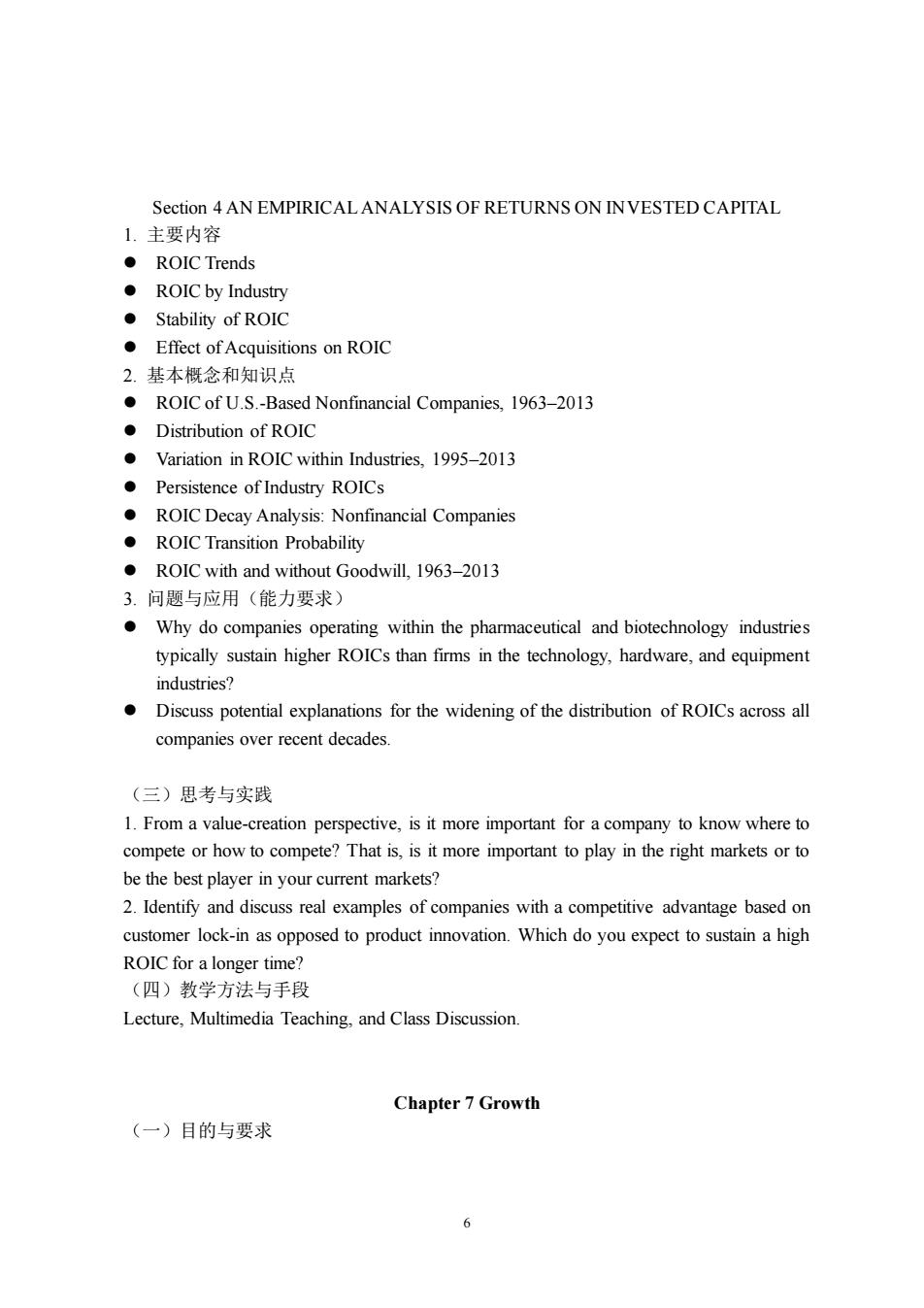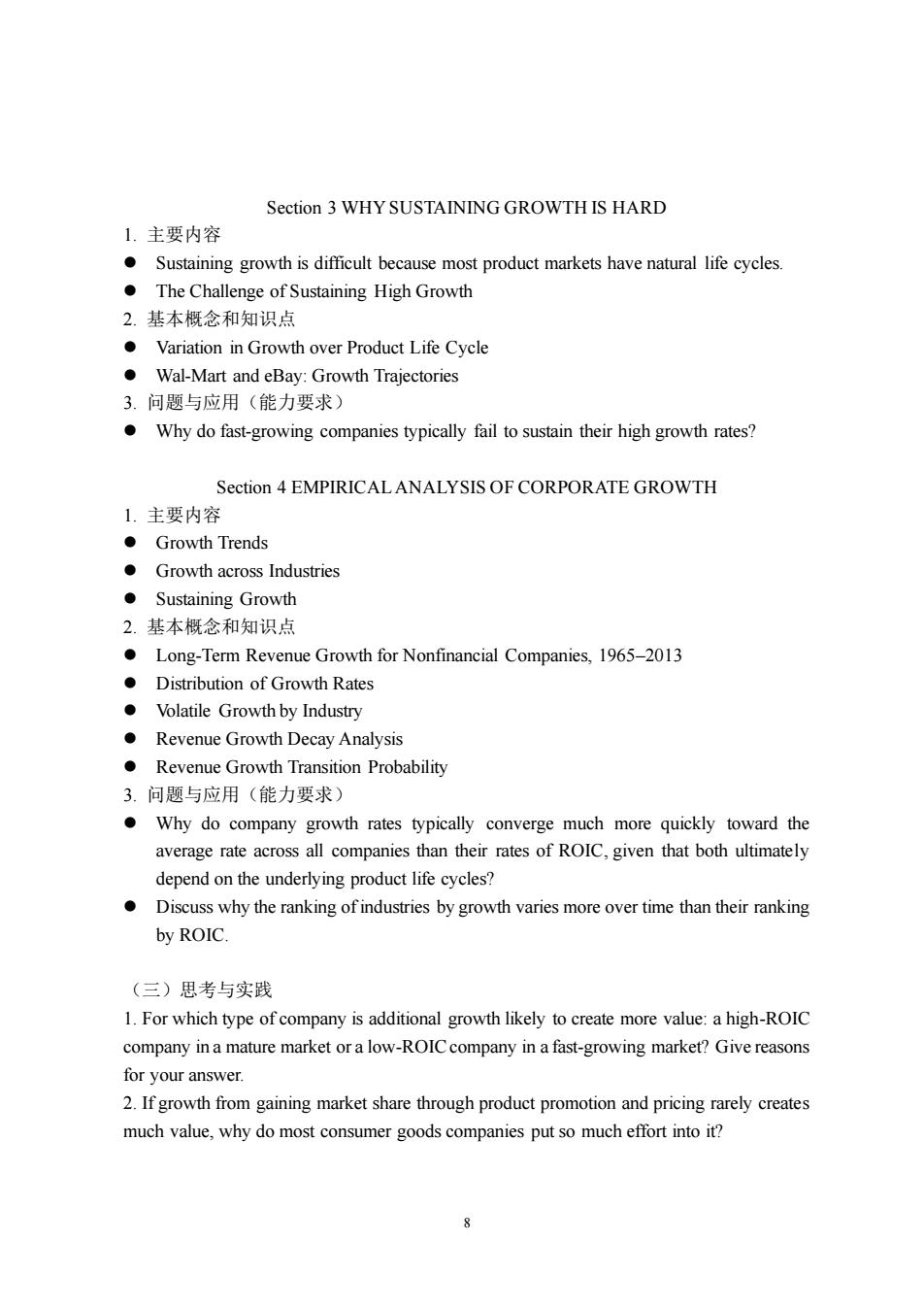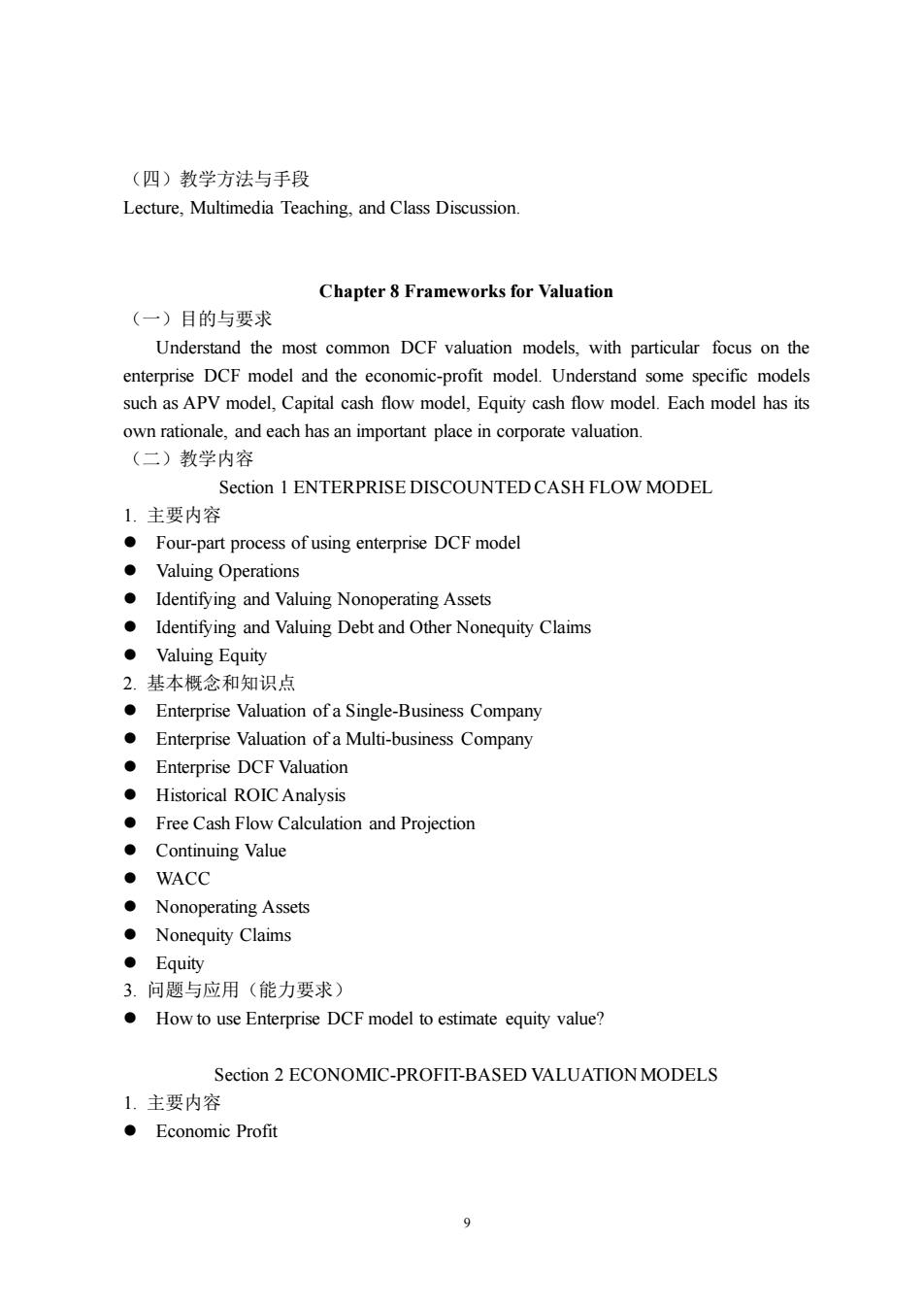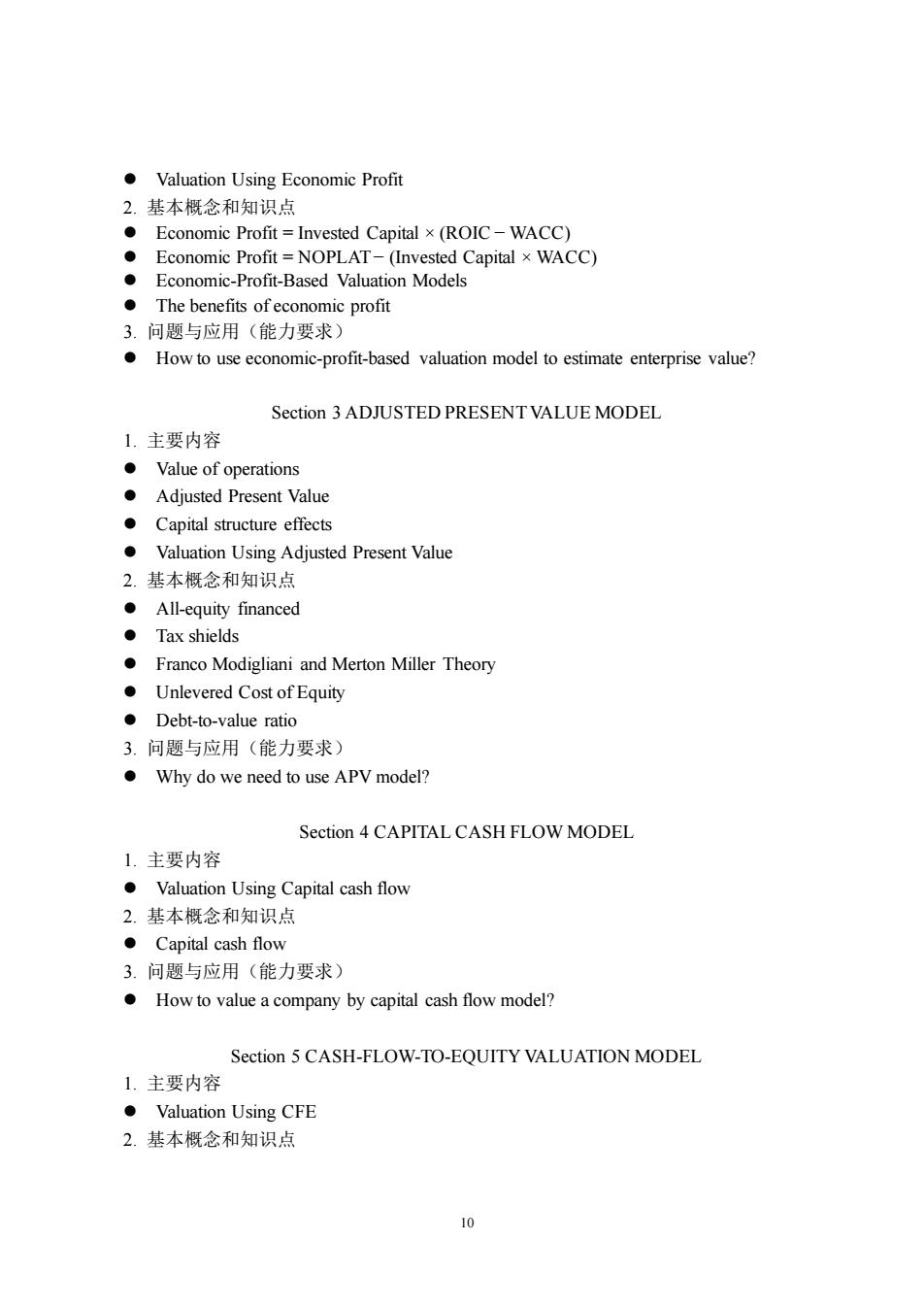
Section 4 AN EMPIRICALANALYSIS OF RETURNS ON INVESTED CAPITAL 1.主要内容 ●ROICTrends ●ROIC by Industry ●Stability of ROIC Effect of Acquisitions on ROIC 2.基本概念和知识点 ROIC of U.S.-Based Nonfinancial Companies,1963-2013 ●Distribution of ROIC Variation in ROIC within Industries,1995-2013 o Persistence of Industry ROICs ROIC Decay Analysis:Nonfinancial Companies ROIC Transition Probability ROIC with and without Goodwill,1963-2013 3.问题与应用(能力要求) Why do companies operating within the pharmaceutical and biotechnology industries typically sustain higher ROICs than firms in the technology,hardware,and equipment industries? Discuss potential explanations for the widening of the distribution of ROICs across all companies over recent decades (三)思考与实践 1.From a value-creation perspective.is it more important for a company to know where to compete or how to compete?That is,is it more important to play in the right markets or to be the best player in your current markets? 2.Identify and discuss real examples of companies with a competitive advantage based on customer lock-in as opposed to product innovation.Which do you expect to sustain a high ROIC for a longer time? (四)教学方法与手段 Lecture,Multimedia Teaching,and Class Discussion. Chapter 7 Growth (一)目的与要求 6
6 Section 4 AN EMPIRICAL ANALYSIS OF RETURNS ON INVESTED CAPITAL 1. 主要内容 ⚫ ROIC Trends ⚫ ROIC by Industry ⚫ Stability of ROIC ⚫ Effect of Acquisitions on ROIC 2. 基本概念和知识点 ⚫ ROIC of U.S.-Based Nonfinancial Companies, 1963–2013 ⚫ Distribution of ROIC ⚫ Variation in ROIC within Industries, 1995–2013 ⚫ Persistence of Industry ROICs ⚫ ROIC Decay Analysis: Nonfinancial Companies ⚫ ROIC Transition Probability ⚫ ROIC with and without Goodwill, 1963–2013 3. 问题与应用(能力要求) ⚫ Why do companies operating within the pharmaceutical and biotechnology industries typically sustain higher ROICs than firms in the technology, hardware, and equipment industries? ⚫ Discuss potential explanations for the widening of the distribution of ROICs across all companies over recent decades. (三)思考与实践 1. From a value-creation perspective, is it more important for a company to know where to compete or how to compete? That is, is it more important to play in the right markets or to be the best player in your current markets? 2. Identify and discuss real examples of companies with a competitive advantage based on customer lock-in as opposed to product innovation. Which do you expect to sustain a high ROIC for a longer time? (四)教学方法与手段 Lecture, Multimedia Teaching, and Class Discussion. Chapter 7 Growth (一)目的与要求

To maximize value for their shareholders,companies should understand what drives growth and what makes it value-creating.Long-term revenue growth for large companies is largely driven by the growth of the markets in which they operate.Although gains in market share contribute to revenues in the short term,these are far less important for long-term growth.Revenue growth is not all that matters for creating value:the value created per dollar of additional revenues is the crucial point Sustaining high growth is no less a challenge than initiating it (二)教学内容 Section 1 DRIVERS OF REVENUE GROWTH 1.主要内容 Disaggregate revenue growth into its three main components Variation in Revenue Growth by Industry Understand markets in the fine-grained way and the differences in companies'revenue growth 2.基本概念和知识点 ●Portfolio momentum Market share performanc Mergers and acquisitions Analyze market growth at the level of individual product and geographical segments 3.问题与应用(能力要求) Discuss the three generic sources of a company's growth,their relative importance for its growth,and what this means for a company's strategy. section 2 growthAnd VALUE CREATION 1.主要内容 Value of Major Types of Growth and Rationale Relationship between growth and value creation 2.基本概念和知识点 。Types of Growth ●Value Creatior 3.问题与应用(能力要求) Why could growth through a series ofbolt-on acquisitions create more value than growth through a single large acquisition? Identify and discuss an example where growth in market share through a price war created long-term value for a company. 7
7 To maximize value for their shareholders, companies should understand what drives growth and what makes it value-creating. Long-term revenue growth for large companies is largely driven by the growth of the markets in which they operate. Although gains in market share contribute to revenues in the short term, these are far less important for long-term growth. Revenue growth is not all that matters for creating value; the value created per dollar of additional revenues is the crucial point. Sustaining high growth is no less a challenge than initiating it. (二)教学内容 Section 1 DRIVERS OF REVENUE GROWTH 1. 主要内容 ⚫ Disaggregate revenue growth into its three main components ⚫ Variation in Revenue Growth by Industry ⚫ Understand markets in the fine-grained way and the differences in companies’ revenue growth 2. 基本概念和知识点 ⚫ Portfolio momentum ⚫ Market share performance ⚫ Mergers and acquisitions ⚫ Analyze market growth at the level of individual product and geographical segments 3. 问题与应用(能力要求) ⚫ Discuss the three generic sources of a company’s growth, their relative importance for its growth, and what this means for a company’s strategy. Section 2 GROWTH AND VALUE CREATION 1. 主要内容 ⚫ Value of Major Types of Growth and Rationale ⚫ Relationship between growth and value creation 2. 基本概念和知识点 ⚫ Types of Growth ⚫ Value Creation 3. 问题与应用(能力要求) ⚫ Why could growth through a series of bolt-on acquisitions create more value than growth through a single large acquisition? ⚫ Identify and discuss an example where growth in market share through a price war created long-term value for a company

Section 3 WHY SUSTAINING GROWTH IS HARD 1.主要内容 Sustaining growth is difficult because most product markets have natural life cycles. The Challenge of Sustaining High Growth 2.基本概念和知识点 Variation in Growth over Product Life Cycle Wal-Mart and eBay:Growth Trajectories 3问颗与应用(能力要求) Why do fast-growing companies typically fail to sustain their high growth rates? Section 4 EMPIRICALANALYSIS OF CORPORATE GROWTH 1.主要内容 ●Growth Trends Growth across Industries ●Sustaining growth 2.基本概念和知识点 Long-Term Revenue Growth for Nonfinancial Companies,1965-2013 Distribution of Growth Rates Volatile Growth by Industry Revenue Growth Decay Analysis Revenue Growth Transition Probability 3.问题与应用(能力要求) Why do company growth rates typically converge much more quickly toward the average rate across all companies than their rates of ROIC,given that both ultimately depend on the underlying product life cycles? Discuss why the ranking of industries by growth varies more over time than their ranking by ROIC (三)思考与实践 1.For which type of company is additional growth likely to create more value:a high-ROIC company in a mature market or a low-ROICcompany in a fast-growing market?Give reasons for your answer. 2.If growth from gaining market share through product promotion and pricing rarely creates much value,why do most consumer goods companies put so much effort into it? 8
8 Section 3 WHY SUSTAINING GROWTH IS HARD 1. 主要内容 ⚫ Sustaining growth is difficult because most product markets have natural life cycles. ⚫ The Challenge of Sustaining High Growth 2. 基本概念和知识点 ⚫ Variation in Growth over Product Life Cycle ⚫ Wal-Mart and eBay: Growth Trajectories 3. 问题与应用(能力要求) ⚫ Why do fast-growing companies typically fail to sustain their high growth rates? Section 4 EMPIRICAL ANALYSIS OF CORPORATE GROWTH 1. 主要内容 ⚫ Growth Trends ⚫ Growth across Industries ⚫ Sustaining Growth 2. 基本概念和知识点 ⚫ Long-Term Revenue Growth for Nonfinancial Companies, 1965–2013 ⚫ Distribution of Growth Rates ⚫ Volatile Growth by Industry ⚫ Revenue Growth Decay Analysis ⚫ Revenue Growth Transition Probability 3. 问题与应用(能力要求) ⚫ Why do company growth rates typically converge much more quickly toward the average rate across all companies than their rates of ROIC, given that both ultimately depend on the underlying product life cycles? ⚫ Discuss why the ranking of industries by growth varies more over time than their ranking by ROIC. (三)思考与实践 1. For which type of company is additional growth likely to create more value: a high-ROIC company in a mature market or a low-ROIC company in a fast-growing market? Give reasons for your answer. 2. If growth from gaining market share through product promotion and pricing rarely creates much value, why do most consumer goods companies put so much effort into it?

(四)教学方法与手段 Lecture,Multimedia Teaching,and Class Discussion Chapter 8 Frameworks for Valuation (一)目的与要求 Understand the most common DCF valuation models,with particular focus on the enterprise DCF model and the economic-profit model.Understand some specific models such as APV model,Capital cash flow model,Equity cash flow model.Each model has its own rationale,and each has an important place in corporate valuation. (二)教学内容 Section 1 ENTERPRISE DISCOUNTED CASH FLOW MODEL 1.主要内容 Four-part process of using enterprise DCF model ●Valuing Operations Identifying and Valuing Nonoperating Assets Identifying and Valuing Debt and Other Nonequity Claims ●Valuing Equity 2.基本概念和知识点 Enterprise Valuation ofa Single-Business Company Enterprise Valuation ofa Multi-business Company Enterprise DCF Valuation Historical ROIC Analysis Free Cash Flow Calculation and Projection ●Continuing Value ·WACC ●Nonoperating Assets ●Nonequity Claims ●Equity 3.问题与应用(能力要求) How to use Enterprise DCFmodel to estimate equity value? Section 2 ECONOMIC-PROFIT-BASED VALUATION MODELS 1.主要内容 ●Economic Profit
9 (四)教学方法与手段 Lecture, Multimedia Teaching, and Class Discussion. Chapter 8 Frameworks for Valuation (一)目的与要求 Understand the most common DCF valuation models, with particular focus on the enterprise DCF model and the economic-profit model. Understand some specific models such as APV model, Capital cash flow model, Equity cash flow model. Each model has its own rationale, and each has an important place in corporate valuation. (二)教学内容 Section 1 ENTERPRISE DISCOUNTED CASH FLOW MODEL 1. 主要内容 ⚫ Four-part process of using enterprise DCF model ⚫ Valuing Operations ⚫ Identifying and Valuing Nonoperating Assets ⚫ Identifying and Valuing Debt and Other Nonequity Claims ⚫ Valuing Equity 2. 基本概念和知识点 ⚫ Enterprise Valuation of a Single-Business Company ⚫ Enterprise Valuation of a Multi-business Company ⚫ Enterprise DCF Valuation ⚫ Historical ROIC Analysis ⚫ Free Cash Flow Calculation and Projection ⚫ Continuing Value ⚫ WACC ⚫ Nonoperating Assets ⚫ Nonequity Claims ⚫ Equity 3. 问题与应用(能力要求) ⚫ How to use Enterprise DCF model to estimate equity value? Section 2 ECONOMIC-PROFIT-BASED VALUATION MODELS 1. 主要内容 ⚫ Economic Profit

Valuation Using Economic Profit 2.基本概念和知识点 Economic Profit Invested Capital x(ROIC-WACC) Economic Profit =NOPLAT-(Invested Capital x WACC) o Economic-Profit-Based valuation Models The benefits ofeconomic profit 3.问题与应用(能力要求) How to use economic-profit-based valuation model to estimate enterprise value? Section s adjusted presentvAlue mODel 1.主要内容 ●Value of operations Adjusted Present Value Capital structure effects Valuation Using Adjusted Present Value 2.基本概念和知识点 ●All-equity financed ●Tax shields Franco Modigliani and Merton Miller Theory Unlevered Cost of Equity ●Debt-to-value ratio 3.问题与应用(能力要求》 Why do we need to use APV model? Section 4 CAPITAL CASH FLOW MODEL 1.主要内容 Valuation Using Capital cash flow 2.基本概念和知识点 ●Capital cash flow 3.问题与应用(能力要求) How to value a company by capital cash flow model? Section 5 cash-flow-to-eoulty vAlUATION MODEL 1.主要内容 ●Valuation Using CFE 2.基本概念和知识点 10
10 ⚫ Valuation Using Economic Profit 2. 基本概念和知识点 ⚫ Economic Profit = Invested Capital × (ROIC − WACC) ⚫ Economic Profit = NOPLAT − (Invested Capital × WACC) ⚫ Economic-Profit-Based Valuation Models ⚫ The benefits of economic profit 3. 问题与应用(能力要求) ⚫ How to use economic-profit-based valuation model to estimate enterprise value? Section 3 ADJUSTED PRESENT VALUE MODEL 1. 主要内容 ⚫ Value of operations ⚫ Adjusted Present Value ⚫ Capital structure effects ⚫ Valuation Using Adjusted Present Value 2. 基本概念和知识点 ⚫ All-equity financed ⚫ Tax shields ⚫ Franco Modigliani and Merton Miller Theory ⚫ Unlevered Cost of Equity ⚫ Debt-to-value ratio 3. 问题与应用(能力要求) ⚫ Why do we need to use APV model? Section 4 CAPITAL CASH FLOW MODEL 1. 主要内容 ⚫ Valuation Using Capital cash flow 2. 基本概念和知识点 ⚫ Capital cash flow 3. 问题与应用(能力要求) ⚫ How to value a company by capital cash flow model? Section 5 CASH-FLOW-TO-EQUITY VALUATION MODEL 1. 主要内容 ⚫ Valuation Using CFE 2. 基本概念和知识点